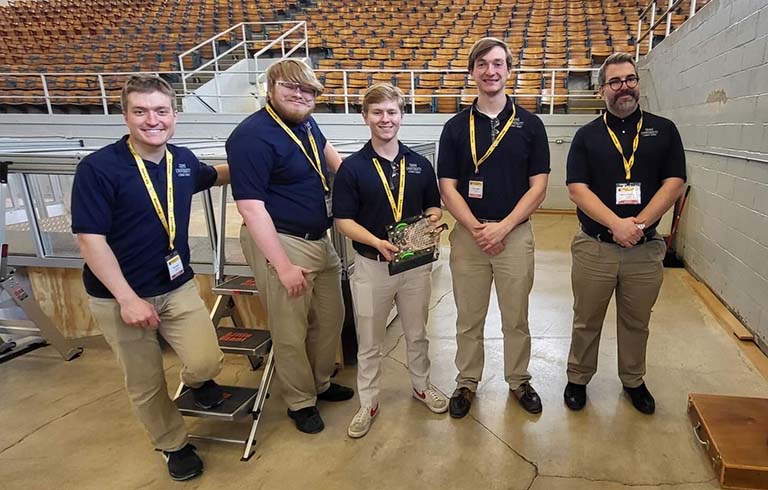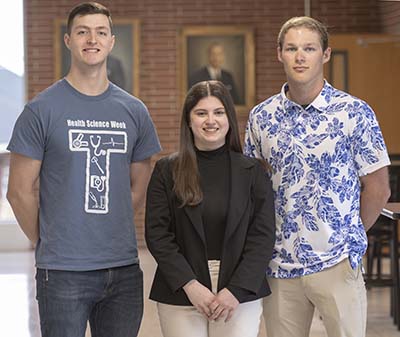
Trine’s armored robot finishes 4th in national combat
Though its opponents were not what was expected, Trine University’s entry in the National Robotics Challenge (NRC) combat robot competition brought innovations of its own.
April 23, 2024

Chemical engineering majors Travis Mersing of Swanton, Ohio, Zaavan Clear of Auburn, Indiana, and Alexandra Davidson of Glenside, Pennsylvania, designed a concept for a plant that would use hydrogen produced by renewable energy to create methane, which could be stored and later used in the power grid.
The project was entered in the annual national Student Design Competition held by the American Institute of Chemical Engineers (AIChE). Students in Trine’s McKetta Department of Chemical and Bioprocess Engineering complete a project for the competition in addition to their industry-based senior design project, either as an individual or part of a team.
Trine students completed eight unique design proposals for this year’s contest.
In the competition, chemical engineers from a designated company devise and judge a student contest problem that typifies a real, working chemical engineering design situation.
“This year’s contest problem does a good job of highlighting some of the global challenges facing society and how chemical engineers are addressing these challenges,” said John Wagner, Ph.D., chair of Trine’s McKetta Department of Chemical and Bioprocess Engineering.
Winners will be announced in mid-October and will have the opportunity to present at the annual AIChE student conference, held Oct. 26-28 in San Diego, California.
Leftover power
This year, teams were tasked with designing a power-to-gas plant, which uses renewable energy such as wind or solar to split water into hydrogen and water. The hydrogen is combined with captured carbon dioxide to produce methane, which can be used in the power grid as natural gas.
Such plants reduce carbon emissions and reduce energy waste in renewable sources by converting excess energy into a form that is usable in the current power grid.
Designs had to effectively manage safety risks, determine the most economical, reliable and environmentally friendly carbon dioxide source, and develop the best method of delivering methane that could be used in current distribution systems.
“We were excited to have the opportunity to apply everything we have been learning over the past four years into one project, knowing chemical engineering students all across the country would be completing the same challenge as well,” Mersing said.
Balancing safety, cost, impact
The Trine team begin by extensively researching current, past and future processes and technologies, then determining which offered the best balance of cost, efficiency and environmental impact.
“We were largely concerned with ensuring we had a safe, functioning design that also met our environmental and production goals,” Davidson said. “Since much of the design utilized newer, less developed technologies, we knew cost would be an issue, so we ended up analyzing how future price structure changes could improve the viability of the design.”
Once the research was done, the team applied principles learned through their coursework to produce their final design.
“From completing material and energy balances over the system, to taking into consideration reactor kinetics, to completing an economic analysis on the entire plant, we had the opportunity to pull pieces of information from each of our classes and combine them to produce a complete design,” Davidson said.
One of the challenges the group overcame during the process was estimating the scale of the equipment needed without being able to build it.
“We could calculate that we were going to capture a given quantity of CO2, but we had to verify that the equipment sizes related to these calculations were realistic. This involved cross-checking materials of construction and equipment sizes to existing processes and standards of practice,” Mersing said.
In addition to the opportunity to apply concepts from their engineering classes, the team enjoyed learning and practicing project management skills.
“Being handed a very broad project and given one month to fully develop a design and complete a process evaluation required a lot of planning and communication among team members,” said Clear. “Of our graduating class, probably only one or two students will have a career in design, but all of us will find ourselves in need of good project management skills regularly.”